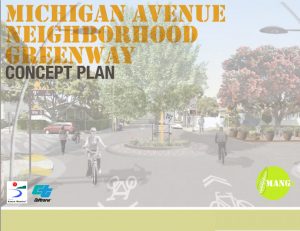(If you’re looking to show support for the Michigan Avenue Neighborhood Greenway and can’t make tomorrow’s meeting, Santa Monica Spoke has a good list of links and draft letters. – DN)

With MANGo, the Michigan Avenue Neighborhood Greenway proposal, going to the City Council tomorrow night, the final staff report for the progressive program was released last week. Interest groups throughout the city are staking out positions on both sides of the issue. The powerful Santa Monicans for Renters Rights (SMRR) came out against the proposal at a meeting on Saturday. Santa Monica Spoke, the local chapter of the Los Angeles County Bicycle Coalition, released the above letter supporting the proposal on Friday.
The Michigan Avenue Neighborhood Greenway will create an inviting streetscape by calming and reducing traffic, increased landscaping, sidewalk widening, bike facilities, and enhanced crosswalks. The three-mile Greenway between the Bergamot Arts Center and the beach will provide a safe and comfortable place for neighbors of all ages to walk, bike, recreate, and interact with one another. MANGo is funded by a Caltrans environmental justice grant.
SMRR is concerned the improvements will trap neighbors inside the Pico Neighborhood by reducing the ability of motorized vehicles to easily traverse the street. Spoke and other backers argue the project makes it easier and safer for all road users.
The two key points of debate that remain are whether or not the city should employ traffic diverters to calm traffic on the street and how low should city’s car traffic goals be set.
On the issue of diverters, Spoke is not asking the city to place diverters in the first phase of the project. Rather, they are asking that if the city is not able to meet its traffic reduction goals, that staff be empowered to create traffic diverters at key intersections without having to come back to the City Council.
On traffic reduction, Spoke is asking that the city be more aggressive than the targets set out in the traffic report. Currently, over 4,200 cars access what should be a quiet residential street that is dotted with schools. Instead, cars use the street as a local alternative to the I-10, especially during rush hour. Spoke is asking that the traffic reduction target be set at a lower number, closer to 1,500 cars, to meet national standards.
The difference in what reduced traffic calming would mean to non-motorized transportation users is explained in the letter.
Let’s do a thought experiment with simple math. Assume a certain block has an ADT of 3,600. A traffic engineering rule of thumb is that for suburban streets, ADT/10 roughly equals peak-hour volume (PHV), i.e. volume at the busiest hour. 3,600/10 = 360. Let’s further assume that motor traffic volume in each direction is equal during peak hour, i.e. 180 cars per direction in peak hour. Let’s even further assume that the cars are spaced evenly, instead of in bursts (“platoons”). There are 3,600 seconds in an hour, so that’s 1 oncoming car every 20 seconds in each direction past a stationary point. (A bicyclist’s experience while moving would be different, because closing speed from behind would be lower — longer gaps between potential passers — than ahead.)
From a motorist’s perspective, 20 seconds is tight to execute a safe pass. Some will rush past, some will pass a bicyclist (let alone two bicyclists riding abreast) too closely, and some will become impatient if enough time elapses without a gap they consider acceptable.
Now let’s cut the ADT, hence the PHV, in half — to 1,800. Our hypothetical, mathematically perfect street now has 40-second passing gaps. That’s comfortable for an un-hurried full-street pass. At 900 ADT the gaps would be 80 seconds — over a minute. You get the picture.
For more on MANGo, visit the Planning Department’s website for the project. Santa Monica Next’s Lindsey Miller will cover the City Council meeting tomorrow night.
